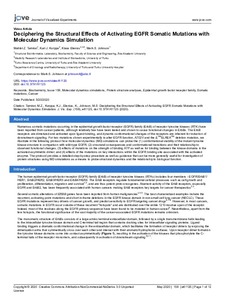Deciphering the Structural Effects of Activating EGFR Somatic Mutations with Molecular Dynamics Simulation
Mahlet Z. Tamirat; Kari J. Kurppa; Klaus Elenius; Mark S. Johnson
Deciphering the Structural Effects of Activating EGFR Somatic Mutations with Molecular Dynamics Simulation
Mahlet Z. Tamirat
Kari J. Kurppa
Klaus Elenius
Mark S. Johnson
MYJoVE Corp.
Julkaisun pysyvä osoite on:
https://urn.fi/URN:NBN:fi-fe2021042823976
https://urn.fi/URN:NBN:fi-fe2021042823976
Tiivistelmä
Numerous somatic mutations occurring in the epidermal growth factor receptor (EGFR) family (ErbB) of receptor tyrosine kinases (RTK) have been reported from cancer patients, although relatively few have been tested and shown to cause functional changes in ErbBs. The ErbB receptors are dimerized and activated upon ligand binding, and dynamic conformational changes of the receptors are inherent for induction of downstream signaling. For two mutations shown experimentally to alter EGFR function, A702V and the Delta(746)ELREA(750) deletion mutation, we illustrate in the following protocol how molecular dynamics (MD) simulations can probe the (1) conformational stability of the mutant tyrosine kinase structure in comparison with wild-type EGFR; (2) structural consequences and conformational transitions and their relationship to observed functional changes; (3) effects of mutations on the strength of binding ATP as well as for binding between the kinase domains in the activated asymmetric dimer; and (4) effects of the mutations on key interactions within the EGFR binding site associated with the activated enzyme. The protocol provides a detailed step-by-step procedure as well as guidance that can be more generally useful for investigation of protein structures using MD simulations as a means to probe structural dynamics and the relationship to biological function.
Kokoelmat
- Rinnakkaistallenteet [27094]
